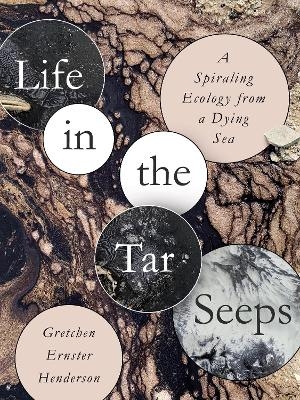
Life in the Tar Seeps
Overlooked Ecologies at Great Salt Lake and Beyond
2022
Trinity University Press,U.S. (Verlag)
978-1-59534-955-2 (ISBN)
Trinity University Press,U.S. (Verlag)
978-1-59534-955-2 (ISBN)
- Noch nicht erschienen
- Portofrei ab CHF 40
- Auch auf Rechnung
- Artikel merken
Finding an intricate web of life in the tar seeps of the Great Salt Lake
At Great Salt Lake, near Robert Smithson’s iconic earthwork Spiral Jetty, a motley crew of scientists walks the mudflats to study fossils in the making. This reputedly dead sea is home to countless tar seeps, pools of raw oil that act as the perfect preservative, encasing organisms as they were in life.
In this spare landscape, an intricate web of life unfurls. Halophiles—salt-hungry microorganisms—tint the brackish water pink and orange; crystals of gypsum stud the ground, glistening underfoot; and pelicans and other migratory birds stop for a crucial rest. Barn owls and seagulls flirt with their prey around the oozing microbial constellations, sometimes falling prey to the oil themselves. Gretchen Henderson came to the tar seeps, a kind of natural asphalt, after recovering from being hit by a car as she walked in a crosswalk—a manufactured asphalt. Like the spiraling artwork that made the Great Salt Lake’s northeastern shore famous, Henderson’s associations of life and death, degeneration and regeneration, and injury and healing came together as she reexamined the pressing questions this delicate area revealed about the climate crisis.
How do we move beyond narrow concepts of the beautiful and the ugly to care for ecosystems that evolve over time? How do we confront our vulnerability to recognize kindred dynamics in our living planet? Through shifting lake levels, bird migrations, microbial studies, environmental arts, and cultural histories shaped by indigenous knowledge and colonial legacies, Life in the Tar Seeps contemplates the ways others have understood this overlooked region. As Henderson witnesses scientists, curators, land managers, and students working collaboratively to steward a challenging place, she grows to see the lake not as dead but as a watershed for shifting perceptions and a meditation on the environmental healing of the planet.
Henderson illustrates her journey with her own vivid photographs of tar seeps and pelican death assemblages, historic maps, and contemporary art and includes a wayfinding guide for exploring places of our own.
At Great Salt Lake, near Robert Smithson’s iconic earthwork Spiral Jetty, a motley crew of scientists walks the mudflats to study fossils in the making. This reputedly dead sea is home to countless tar seeps, pools of raw oil that act as the perfect preservative, encasing organisms as they were in life.
In this spare landscape, an intricate web of life unfurls. Halophiles—salt-hungry microorganisms—tint the brackish water pink and orange; crystals of gypsum stud the ground, glistening underfoot; and pelicans and other migratory birds stop for a crucial rest. Barn owls and seagulls flirt with their prey around the oozing microbial constellations, sometimes falling prey to the oil themselves. Gretchen Henderson came to the tar seeps, a kind of natural asphalt, after recovering from being hit by a car as she walked in a crosswalk—a manufactured asphalt. Like the spiraling artwork that made the Great Salt Lake’s northeastern shore famous, Henderson’s associations of life and death, degeneration and regeneration, and injury and healing came together as she reexamined the pressing questions this delicate area revealed about the climate crisis.
How do we move beyond narrow concepts of the beautiful and the ugly to care for ecosystems that evolve over time? How do we confront our vulnerability to recognize kindred dynamics in our living planet? Through shifting lake levels, bird migrations, microbial studies, environmental arts, and cultural histories shaped by indigenous knowledge and colonial legacies, Life in the Tar Seeps contemplates the ways others have understood this overlooked region. As Henderson witnesses scientists, curators, land managers, and students working collaboratively to steward a challenging place, she grows to see the lake not as dead but as a watershed for shifting perceptions and a meditation on the environmental healing of the planet.
Henderson illustrates her journey with her own vivid photographs of tar seeps and pelican death assemblages, historic maps, and contemporary art and includes a wayfinding guide for exploring places of our own.
Gretchen Ernster Henderson is a senior lecturer at The University of Texas at Austin. Her recent writing has appeared in Ecotone (Notable in Best American Essays 2020), Ploughshares, The Kenyon Review, Notre Dame Review, and many other journals, with co-authored work in Nature Sustainability and Conservation Biology. Her previous books include Ugliness: A Cultural History and Galerie de Difformité. Her opera libretto on the climate crisis, Cassandra in the Temples, premiered at MIT. She lives in Tucson, Arizona.
| Erscheinungsdatum | 14.07.2021 |
|---|---|
| Zusatzinfo | black and white photos throughout |
| Verlagsort | San Antonio |
| Sprache | englisch |
| Maße | 139 x 215 mm |
| Themenwelt | Literatur ► Essays / Feuilleton |
| ISBN-10 | 1-59534-955-3 / 1595349553 |
| ISBN-13 | 978-1-59534-955-2 / 9781595349552 |
| Zustand | Neuware |
| Haben Sie eine Frage zum Produkt? |
Mehr entdecken
aus dem Bereich
aus dem Bereich
vom Zustand der Debatte in der Digitalmoderne
Buch | Hardcover (2023)
Kiepenheuer & Witsch (Verlag)
CHF 30,80
so erkennst du dein wahres Ich
Buch | Hardcover (2024)
Piper (Verlag)
CHF 26,90
die dunkle Geschichte der reichsten deutschen Unternehmerdynastien
Buch | Softcover (2024)
Kiepenheuer & Witsch (Verlag)
CHF 22,40


